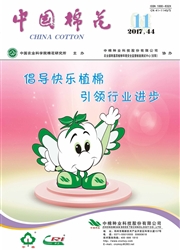

 中文摘要:
中文摘要:
为了研究塔里木绿洲种植制度对棉田土壤养分特性的影响,以棉田轮作方式(水稻→棉花、水稻→冬麦→棉花、水稻→冬麦-绿肥→棉花)和连作年限(3、5、8、10、15 a)为试验因素,对0~100 cm土层土壤进行了调查与试验。结果表明:短期轮作对棉田土壤养分含量无影响,棉花连作年限是不同层次土壤养分含量变化的主要影响因素,连作3、8、10、15 a土壤0~20 cm速效氮平均为40.60、48.75、51.96、44.35 mg/kg;速效磷平均为10.16、26.72、27.00、23.37 mg/kg;速效钾平均为184.70、142.60、130.20、105.56 mg/kg;有机质含量分别为10.43 g/kg、12.10g/kg、12.93 g/kg、13.56 mg/kg;无论轮作类型、连作年限长短,从垂直分布上,连作15 a、3 a土壤速效氮F值分别为79.01、299.45;速效磷F值分别为88.99、17.54;有机质F值分别为77.27和171.6。表明长期连作降低了上下层土壤速效氮和有机质含量差异而增加了上下层土壤速效磷含量差异;有机质含量随着土层深度的增加而降低;速效钾含量有随着土层深度的增加而增加的趋势。棉花长期连作有利于增加各层次土壤速效氮、速效磷和有机质含量,同时降低深层土壤速效钾的含量;连作8~10 a耕作层土壤速效氮、有效磷含量达到最大值分别为52.35 mg/kg和27.45 mg/kg。
 英文摘要:
英文摘要:
In order to study the effects of cropping system on nutrient characteristics of cotton field in Tarim oasis, both .crop rotation and continuous cropping duration as test factors were adopted to seek the changes of soil chemical prop- erties. The results showed that short - term rotation had no influence on soil nutrient properties. Cotton cropping - year was the main factor to influence the content of nutrition in different soil depth. Available nitrogen in 0 - 20 cm soil layer with 3, 8, 10 and 15 years of continuous cropping was 40.60, 48.75, 51.96 mg/kg and 44.35 mg/kg; available phos-phorus was 10.16, 26.72, 27.00 mg/kg and 23.37 mg/kg; available potassium was 184.70, 142.60, 130.20 mg/kg and 105.56 mg/kg; and organic matter content was 10.43 g/kg, 12.10 g/kg, 12.93 g/kg and 13.56 mg/kg respec- tively. Soil available nitrogen, available phosphorus, organic matter content reduced with the increase of soil depth from vertical distribution, regardless of rotation types and cultivation years. There was a trend that available potassium contend raised with the increase of soil depth. Long-term continuous cropping of cotton increased the level of soil available nitro- gen, available phosphorus and organic matter content while reduced available potassium contenL in deep soil; Soil avail- able nitrogen and phosphorus content reached maximum of 52.35 mg/kg and 27.45 mg/kg after 8-10 years of continu- ous cropping.
 同期刊论文项目
同期刊论文项目
 同项目期刊论文
同项目期刊论文
 期刊信息
期刊信息
